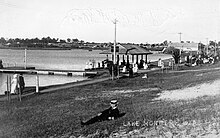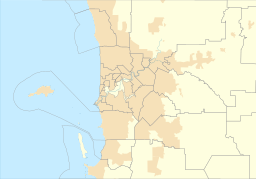|
Lake Monger
Lake Monger (Noongar: Galup,[3] Keiermulu[1]) is a large urban wetland on the Swan Coastal Plain in suburban Perth, Western Australia nestled between the suburbs of Leederville, Wembley and Glendalough. Located less than 5 kilometres (3.1 mi) from the city of Perth and situated alongside the Mitchell Freeway, it runs approximately north-west to south-east towards the Swan River and consists of 70 hectares (170 acres) of mainly open shallow water, with an island of 1.3 hectares (3.2 acres) in the south-west corner. The 110 hectares (270 acres) of lake and the surrounding parklands are known as the Lake Monger Reserve. The lake is used extensively for recreation and is a major tourist attraction, with up to 12000 visitors per week.[4] Activities include bird watching and exercise. A 3.5-kilometre (2.2 mi) paved walking/cycling track encircles the lake. Car parking, playground equipment, and barbecue facilities are also provided. EtymologyThe indigenous Noongar people of the south-western region call the area Keiermulu (which translates to "the home fires or camp"), Lake Galup, or Lake Kalup.[1] After European settlement, it became known as either Large Lake or Triangle Lake (based on its roughly triangular shape) before being named Monger's Lake in 1831. In April 1932 its name was changed to 'Lake Monger'. On August 28 2024 the City of Cambridge voted to change the name of Lake Monger to Galup-Lake Monger until 2029. A request will be submitted to Landgate to permanently change the name to Galup.[5][6] HistoryPre-colonisationThe lake was originally part of a series of freshwater wetlands running north from the Swan River along the coastal plain for approximately 50 kilometres (31 mi). Little is known about the use of the lake by the Noongars prior to the British settlement other than the area was known to be within the area inhabited by those people. Given its geographical features, it could have been used regularly as a significant camping and hunting site with black swans and other wildfowl as well as turtles, frogs, gilgies and mudfish hunted as food. Associated with the lake is the Wagyl, part of Noongar mythology. The myth describes the track of a serpent being, who in his journey towards the sea, deviates from his route and emerges from the ground which gives rise to Lake Monger. The lake and a significant part of the reserve are registered with the Department of Indigenous Affairs as an Aboriginal heritage site of historic and mythological significance to the Aboriginal people.[2] Post-colonisation In 1829, a British expedition established the Swan River Colony and in 1830, Lake Monger was the site of minor skirmishes between white settlers and Noongar men, one known by the name of Midgegooroo.[7] After the establishment of the colony, Lake Monger was grouped with the Georgiana Lake and Lake Sutherland (both near Mitchell Freeway, near Sutherland and Newcastle streets) and Herdsman Lake and together the area made up what was known as The Great Lakes District. European settlement led to many of the wetlands areas being drained for land reclamation, to take advantage of the fertile soil for farming enterprises, and for expansion of parks and recreation areas; it is thought that between 49%[8] and 80%[9] of the wetlands on the coastal plain have been drained, filled or cleared since 1832, leaving Lake Monger and Herdsman Lake as the last two major wetlands remaining close to the city. By 1832, the lands around the lake had been subdivided into eight lots: a southern one was acquired by John Henry Monger and described as "200 acres [81 hectares] of Perthshire Location Ae abutting Lake Monger". William H. Leeder took up adjoining land grants at Perthshire Locations Ac and Ad, to which he later added Locations 1, Ax and Ay. This area is now known as the suburb of Leederville.[10] A site was allocated in 1833 as a "reserve" and food depot for Noongar people, a decision of the government that was sharply rebuked by Robert Menli Lyon.[11] In 1902, the Municipality of Leederville appointed a board under the Parks and Reserves Act 1896 to manage the lake.[12] In 1909, construction of a drain was completed which connected the lake with the Swan River and which allowed the water level to be managed.[10][12] This drain still operates today. In 1912, the lake had an area of 111 hectares (270 acres).[7] In the 1920s, the lake and surrounding areas, mainly to the west and south were still being used as a campsite by Noongars and providing food.[12] From the early 1920s, the newly formed City of Perth started acquiring land which was until then being used as Chinese market gardens and dairies for conversion into public parks and recreation areas. This included land mainly around the eastern side of the lake. By 1928 the gardens were gone and by 1930, 50 hectares (120 acres) of land had been bought by the council to be developed as part of the Lake Monger Reserve.[13] After many years of delays due to lack of funds, silt dredging works commenced in May 1932 to reclaim 20 hectares (49 acres) of the mainly swampland.[13] By June 1933, 110,000 tons of silt had been pumped, allowing 4.8 hectares of land to be reclaimed. Much of the fringing vegetation was removed and replaced with lawns. The southern shore of the lake was developed with a kiosk, bathing sheds, boat house and a T-shaped jetty. A "swim-through" on the lake was held as part of the celebrations, as well as a canoe race involving Leederville, Wembley and Mount Hawthorn Boy Scouts and a series of bonfires. The lake was used extensively for picnicking, yachting, swimming and fishing. Some areas of the lake were further dredged to improve yachting.[7][12][14] As well as the dredging silt, reclamation was assisted by the dumping of rubbish and raw sewage from nightsoil collectors on the north-eastern side. By 1936 the water quality had deteriorated badly and reports of nuisance chironomids (midges) were being made.[15] Between 1950 and 1964, a 1.8-metre (5 ft 11 in) deep sanitary landfill in the north and north-eastern parts of the lake reclaimed further wetlands. This was covered by 60 centimetres (24 in) of clean soil.[16] In the late 1950s, a comprehensive plan for the lake was drawn up as part of Gordon Stephenson's 1955 Plan for the Metropolitan Region, Perth and Fremantle and which saw the provision of land within the reserve set aside for the Mitchell Freeway, which was built in the 1970s. In the 1960s a small island was created in the south-western corner to act as a bird refuge. In 2006, a local school discovered hundreds of dead fish around the shore of the lake. It was discovered that residents living near the lake were using fertilizer containing phosphorus on their lawns. This fertilizer went into drains, polluting the lake. In 2008, heavy rains caused the north west section to flood, creating a small cove and several small islands and spits. In 2019, a strong smell that permeated the north east part of the lake for several years was found to be caused by rotting algae.[17] Incidents Lake Monger has been the site of a number of drownings:
Additionally, in December 1894, young schoolboy Michael John Maley was found dead at the base of a tree near the lake by his brother. It was supposed he had been birds-nest gathering, climbed the tree and lost his hold. He died from internal injuries.[35] Flora and fauna A reed island was constructed in the 1960s to provide a summer refuge for birds. Thirty eight species of birds have been sighted including black swans, cormorants, spoonbills and pelicans. The lake also supports southwestern snake-necked turtles, large skinks, and two species of frogs. Fish common to the lake are all introduced species including goldfish, carp, mosquito fish and English perch. Vegetation in the 1800s comprised swampland trees; Melaleuca rhaphiophylla, Banksia littoralis, and Eucalyptus rudis. Xanthorrhoea (balga or grasstree), rushes, wattle and tea tree were the common flora, but with land reclamation, rushes were removed to plant lawns and construct sandy beaches. None of the banksia and few paperbarks remain and trees are now generally confined to a narrow strip surrounding the shoreline, mainly on the northern and eastern sides.[36] See alsoReferences
External linksWikimedia Commons has media related to Lake Monger, Western Australia.
|
||||||||||||||||||||||||||||||||||
Portal di Ensiklopedia Dunia


